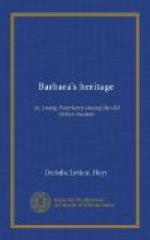At this moment callers were announced and Mr. Sumner said they would resume their talk some other time.
“It will be well for you if you can look at these paintings by Ghirlandajo to-morrow morning if it be a bright day,” he said, “while all that I have told you is fresh in your minds. I cannot go with you, but if you think of anything you would like to ask me about them, you can do so before we begin on Botticelli.”
Chapter IX.
The Coming-out Party.
Like the swell of some
sweet tune,
Morning rises into noon,
May glides onward into June.
—LONGFELLOW.
[Illustration: PALAZZO PITTI, FLORENCE.]
“Well, have you seen Ghirlandajo’s work?” asked Mr. Sumner, the next time the little group met in the library.
“Only his frescoes in Santa Maria Novella. We have spent two entire mornings looking at those,” answered Bettina.
“We took your list of the portraits there with us, uncle,” said Malcom, “and tried to get acquainted with those old Florentine bishops, bankers, and merchants that he painted.”
“And oh! isn’t that Ginevra de’ Benci in the Meeting of Mary and Elizabeth lovely! and her golden brocaded dress!” cried Margery.
“You pay quite a compliment to the old painter’s power of representing men and women,” said Mr. Sumner, “for these evidently captivated you. I wish I could have overheard you talking by yourselves.”
“I fear we could not appreciate the best things, though,” said Barbara. “We imagined ourselves in old Florence of the fifteenth century, and tried to recognize the mountains and palaces in the backgrounds, and we enjoyed the people and admired their fine clothes. I do think, however, that these last seem often too stiff and as if made of metal rather than of silk, satin, or cloth. And when Howard told us that Mr. Ruskin says ‘they hang from the figures as they would from clothes-pegs,’ we could but laugh, and think he is right with regard to some of them. Ought we to admire everything in these old pictures, Mr. Sumner?” she earnestly added.
“Not at all; not by any means. I would not have you think this for a moment. Ghirlandajo’s paintings are famous and worthy because they are such an advance on what was before him. Compare his men and women with those by Giotto. You know how much you found of interest and to admire in Giotto’s pictures when you compared them with Cimabue’s and with the old Greek Byzantine paintings. Just so compare those by Masaccio and Ghirlandajo with what was done before. See the growth,—the steady evolution,—and realize that Ghirlandajo was honest and earnest, and gifted too; that his drawing is firm and truer to nature than that of most contemporary artists; that his portraits possess character; that they are well-bred and important, as the people they represent were; that his mountains are like mountains even in some of their subtile lines; that his rivers wind; that his masses of architecture are in good perspective and proportion; and then you will excuse his faults, though it is right to notice and feel them. We must see many in the work of every artist until we come to the great painters of the High Renaissance. You must find Ghirlandajo’s other pictures, and study them also.”




